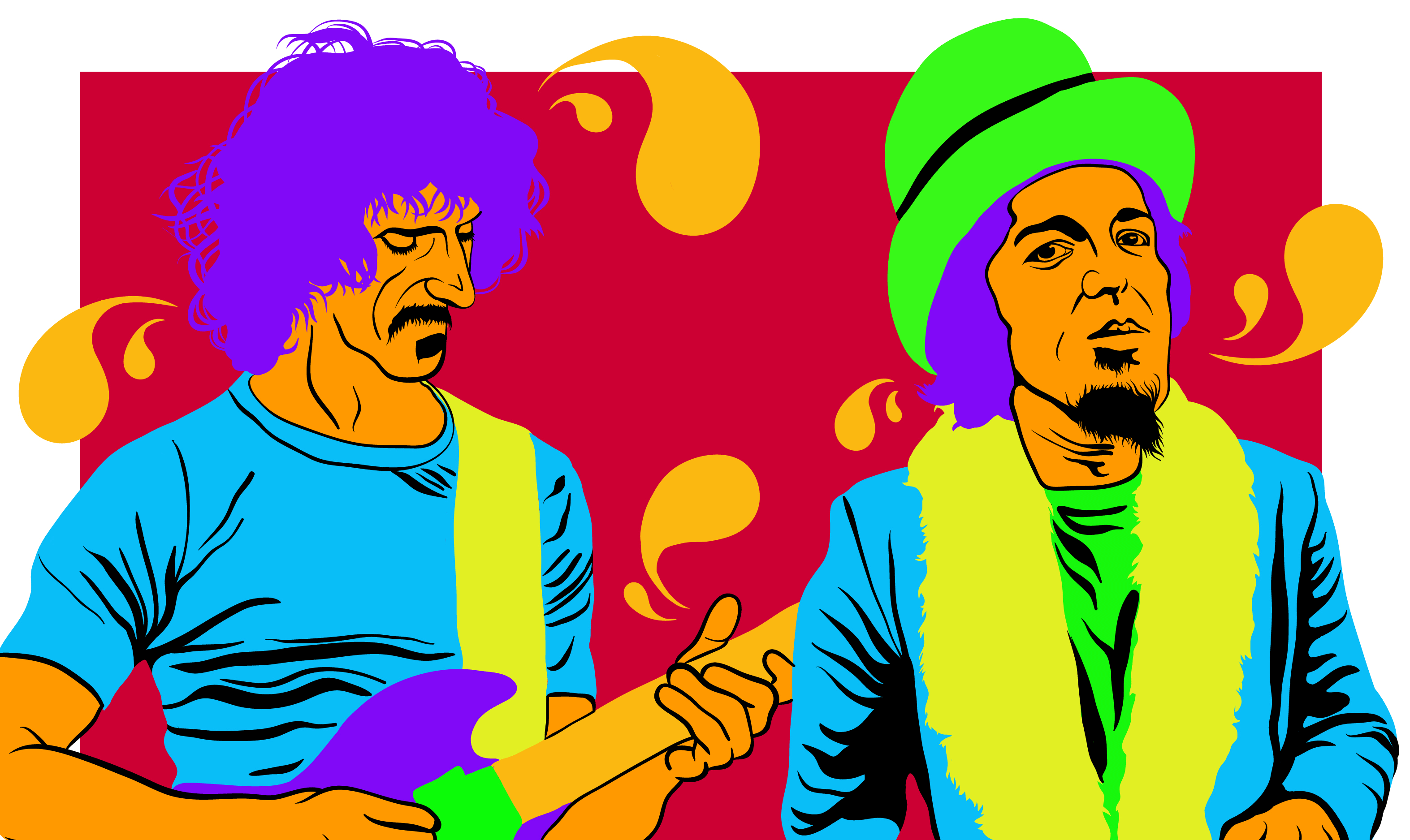Hot Freaks: An Insider’s Guide to Psychedelic Rock in California

“Freaking out is a process whereby an individual casts off outmoded and restricted standards of thinking, dress and social etiquette in order to express CREATIVELY his relationship to his environment and the social structure as a whole” – Frank Zappa
Borne amidst a period of drugs, sex, and political action, the genre of psychedelic rock was both a musical movement and an artistic statement. Emerging from the crevices of world art capitols such as San Francisco and London during an era of crewcuts, cold war and the thawing of a socially conservative America, the long-haired buzz of psychedelic music was the product of various genres, including blues, folk and ethnic Indian music.
Psychedelic music reflects the anti-establish counterculture of the baby-boomer generation, generally viewed as a movement initiated by the British Invasion bands of the earlier 1960’s that experimented with more experimental recording techniques, as well as more experimental drugs. As bands like The Beatles and The Rolling Stones began employing the use of Indian instruments in their compositions and tape loops in their recording, this trend caught on.
Soon enough, every pop band from Los Angeles to Paris was attempting to be the next psychedelic breakthrough.
At this point, a counter-counterculture movement began developing to critique the popular cashing-in on the hippy movement, driving psychedelic music to new experimental extremes. The freak scene, spearheaded by artists like Frank Zappa and Don Van Vliet (aka Captain Beefheart), emerged from the steaming fissure of the San Fernando valley. Contrasting the picturesque hippy youth of San Francisco with colorful clothes and flowers in their hair, these freaks from Los Angeles truly were freaks, dawning long unkempt hair and beards, filthy clothes that belonged in science fiction novels and copious amounts of psychedelic drugs.
The psychedelic scene in California contributed a significant amount creativity to the genre as a whole, as bands such as Love created a dreamy sound of spiritual folk-rock with heavy blues influence, while The United States of America incorporated aspects of avant-garde and musique-concrete. This general movement of melding the avant-garde with radio sensible rock and blues soon caught on across the world. Bands and scenes began pushing the boundaries of what can be considered rock and roll.
Continued through the remainder of the 20th century to today, the psychedelic scene in California remains at the forefront of popular and indie music worldwide.
Bands such as the Brian Jonestown Massacre developed their own unique take on the genre, blending reverb-heavy guitars with slow, repetitive rhythms. Newer bands, such as Mystic Braves and Allah-Lah’s have combined the classic psychedelic sound of the 1960’s with the trademark beach and garage rock of more recent Southern California music, most notably the scene surrounding Burger Records in Fullerton.
This list is meant as a brief, general introduction to the various psychedelic sounds of California, new and old. Although it is far from encapsulating the genre and scene as a whole, I mean for it to be a display of the variety of bands and artists from California who have produced music that in some way has contributed to psychedelic music.
-
Frank Zappa and the Mothers of Invention – Freak Out!
I would argue that this is the definitive record of the Freak Scene in Los Angeles. Opening with the politically charged “Hungry Freaks, Daddy,” this album progresses through a diverse palate of music genres, ranging from the protest blues of “Trouble Everyday” to the doowop parody of “Go Cry on Somebody Else’s Shoulder.” The content of the lyrics ranges from harsh criticism of then President Lyndon Johnson’s Great Society program and the Watts Riots of 1965 to bizarre allusions to Elvis and paranoia. As the album blends blues and rock with avant-garde and noise in tracks like “Who are the Brain Police?” and “Help, I’m a Rock,” the record culminates in the twelve-minute odyssey “The Return of the Son of Monster Magnet,” which can only be described as a music representation of freaking out. As this record came out in 1966 Los Angeles, it seems to foreshadow the fear and violence that ended the hippy movement later in the decade.
-
Captain Beefheart and his Magic Band – Trout Mask Replica
“Very great played at high volume when you’re feeling shitty, because you’ll never feel as shitty as this record.” -Robert Christgau
This album is The Room of music. Polarizing critics who either consider it the best or the worst album ever made, this 1969 double-LP produced by Frank Zappa is undoubtedly one of the most unique collections of songs ever administered in record stores.
Despite its weirdness, fans of this album include Simpsons creator Matt Groening, David Lynch and John Lydon of the Sex Pistols and PiL, who noted that “The first time I played that album, I laughed all the way through.” Infamous for the background story of its creation, which involved Dan van Vliet forcing his band members to stay inside a house and practice for hours on end with little food, the depravity and disgust of these desperate Angelinos shows through the roughness of the songs. Starting with the messed-up blues of “Frownland,” this album is a relentless challenge to listen to, with songs like “Dachau Blues” and “Dali’s Car” sounding like nightmarish renditions of traditional American music. Although this album is painfully inaccessible, it is a prime example of the original merging of avant-garde with rock as it mixes themes of free jazz and music concrete with rock and blues.
-
The United States of America – S/T
Since my first listen to this album, it has remained an enigma to me as it both pushes the boundaries of avant-garde music while simultaneously providing a classic 1960’s pop music sound. The opening medley of “The American Metaphysical Circus” is just as wild as the name would insinuate, and the album does not relent in this noisy chaos.
One important thing to note while listening to this album is the advanced recording techniques and employment of synthesizers, both incredibly progressive for an album released before 1970. “Cloud Song” and “The Garden of Earthly Delights” are two of the most notable examples of the forward-thinking nature of the album, as both employ futuristic sounding electronic effects that could fit in the music of current bands like Animal Collective or Radiohead. The true apex of the record is the nearly seven-minute opus “The American Way of Love,” a three-part journey of psychedelic hard rock that revisits different parts of the album through manipulated tape loops and advanced effects. Although The United States of America only existed for a short time and only released one album, the small amount of work that they put out challenged the popular notion of psychedelic music and remains relevant today.
-
The Brian Jonestown Massacre – Methodrone
Formed in San Francisco in the 1990’s, The Brian Jonestown Massacre has become one of the most prolific bands to emerge from the west coast in recent years. Bringing forth a sound that combines elements of shoegaze, British-invasion, garage-rock, and classic rock, The BJM appeared at the forefront of the psychedelic scene decades after its heyday in the 1960’s. Although the sound on Methodrone evokes the distorted melancholy of British shoegaze acts like Slowdive and Ride, singer Anton Newcombe’s tortured crooning over the band’s fuzzy slow rock is more reminiscent of classic California bands like The Byrds and The Beach Boys. The opening song, “Evergreen,” paints an emotional picture of abandonment and loss with soft female vocals, slow repetitive drums, and low, droning guitars. Other songs, such as “Wasted,” mix the soft neo-psychedelia of Spaceman 3 with the classic Brit-pop funk pioneered through bands like The Rolling Stones and The Stone Roses. As the first album in a large discography that continues to grow today, Methodrone seems to be a moment of clarity for a band that has otherwise faced a very tumultuous existence. As documented in the 2004 movie Dig!, the constant drug abuse and decaying mental state of Newcombe resulted in various arrests and commercial failures throughout the band’s history. Yet, albums like Methodrone stand as a testament to the band’s importance in the California psychedelic scene.
-
Mild High Club – Skiptracing
A newer addition to the psychedelic discography of California, Mild High Club’s 2016 record Skiptracing puts a new spin on an aging genre during the digital age. Combining smooth, hypnotic instrumentals with clean and precise producing, this album reinvents psychedelia for millennials, packaging it with the funk of Steely Dan and the jazz of the Cyrkle. Alexander Brettin’s vocals evoke the feeling one gets while on the verge of falling asleep, processing various abstract lyrics with the slow flow of the instrumentals. Highlights include the opening “Skiptracing,” “Tessellation,” and “Kokopelli,” which all encapsulate the dreamy sound of the album. Since first listening to it, I’ve always enjoyed listening to this album while riding the train south from San Luis Obispo, as this is the perfect soundtrack to watch the sun set over the endless rolling hills of south SLO County.
-
Allah-Lah’s – Calico Review
Different from the soft sway of The BJM and Mild High Club, Allah-Lah’s evoke the heavier sound of urban psychedelic garage rock from bands like The Count Five or The Seeds. Their newest record, Calico Review, is a perfect soundtrack to drive down Sunset Boulevard, creating a steady rock sound that holds closer to the classic psychedelic sound than most current bands. Songs like “200 South La Brea” explicitly portray modern life in the city of Los Angeles, depicting the seemingly endless grid of streets, shops, and buildings built upon a canvas of sand and palm trees. Highlights include “Satisfied,” “High & Dry” (very different from the song of the same name by Radiohead) and my personal favorite, “Roadside Memorial,” whose tom-heavy drum beat and fuzzy bass remind me of the raw psychedelia of The Stooges and MC5.
Ian Ridsdale is a KCPR DJ and Cal Poly political science sophomore. He wrote the copy. His radio show runs on KCPR San Luis Obispo 91.3 FM and KCPR.org on Saturdays from 4 p.m. to 6 p.m. Pamela Moidel is a KCPR staff member and Cal Poly graphic design sophomore. She created the illustration.

